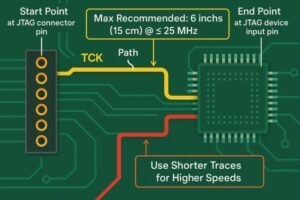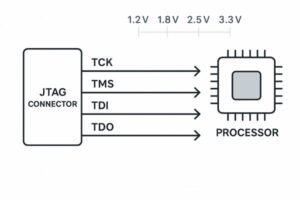Are your stored PCBs degrading, leading to assembly problems or early field failures? Proper storage is an active process of "solderability and reliability preservation," crucial for product success.
Proper PCB storage involves controlling temperature and humidity, using Moisture Barrier Bags with desiccants and Humidity Indicator Cards, employing ESD protection, and selecting appropriate packaging. This preserves solderability and prevents degradation.

Thinking about PCB storage as just putting boards on a shelf until they're needed is a common mistake. I've learned that this passive approach can be costly. Instead, we should treat storage as an active process of "solderability and reliability preservation." It's about implementing a tiered, environment-controlled, and data-driven approach, especially for high-reliability or long-lifecycle products. This philosophy moves beyond a generic "first-in, first-out" (FIFO) system to a "fitness-for-use" model. We base this on real-time or predictive degradation of the PCB's surface finish and its dielectric materials. This helps ensure every board is in top condition for assembly and a long operational life. Let's look at the key aspects of effective PCB storage.
What Is The Ideal Humidity For PCB Storage?
Struggling with boards that fail after assembly? The culprit might be moisture absorbed during storage, silently damaging your components.
Ideally, PCBs should be stored at a relative humidity (RH) below \(40\%\). For long-term storage or highly sensitive boards, levels below \(10\%\) RH are often recommended, particularly when following MSL guidelines.
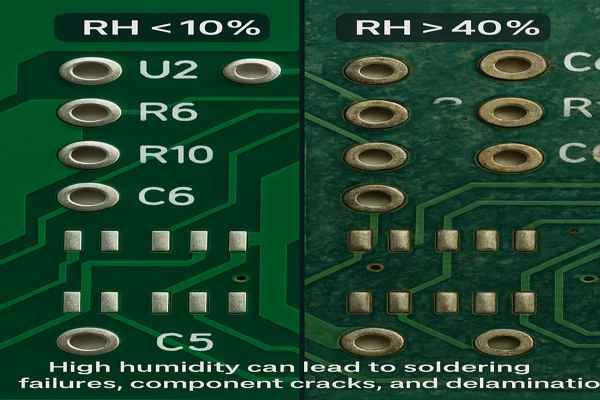
High humidity is a major enemy of PCBs. When humidity levels climb, several problems can arise. I once had a batch of boards with OSP finish become nearly unsolderable because a storage area wasn't properly monitored.
Impact of Humidity on PCBs
The level of humidity can significantly affect PCB integrity, as summarized below:
| Humidity Level | Potential Negative Effects on PCBs |
|---|---|
| High (\(>60\%\) RH) | Rapid Oxidation, Corrosion, Moisture Absorption, Delamination during reflow, Solderability Issues, Promotes Fungal Growth |
| Moderate (\(40-60\%\) RH) | Increased risk of oxidation over long periods, some moisture absorption |
| Ideal (\(<40\%\) RH) | Minimal oxidation, good solderability preservation |
| Very Low (\(<10\%\) RH) | Excellent moisture protection; however, can increase ESD risk if not managed with proper grounding and materials |
Recommended Humidity Levels and Standards
For general storage, maintaining RH below \(40\%\) is a good target. For sensitive components or long-term storage (over a year), IPC/JEDEC J-STD-033D1 ("Handling, Packing, Shipping and Use of Moisture/Reflow Sensitive Surface Mount Devices") suggests \(<10\%\) RH, and for very sensitive situations, \(<5\%\) RH in a nitrogen environment or dry cabinet.
| Condition | Recommended Max RH | Primary Concern | Standard Reference (Example) |
|---|---|---|---|
| Short-term (Bare Boards) | \(<50-60\%\) | Initial Oxidation | Manufacturer Specs |
| General Storage (Bare Boards) | \(<40\%\) | Solderability | IPC-1602 General Guidance |
| Long-term / MSL Assemblies | \(<10\%\) | Moisture Absorption | J-STD-033D |
| Ultra-Sensitive / Longest Term | \(<5\%\) | Max Protection | J-STD-033D |
According to IPC-1602 ("Storage and Handling of Printed Boards"), excessive moisture absorption can lead to delamination or "popcorning."
What Is The Ideal Temperature For PCB Storage?
Worried about your PCBs aging prematurely in storage? High temperatures can degrade materials and finishes much faster than you think.
The ideal temperature for PCB storage is generally below \(25^{\circ}\text{C}\) (\(77^{\circ}\text{F}\)), with some sources recommending even cooler conditions, like below \(22^{\circ}\text{C}\) (\(72^{\circ}\text{F}\)). Avoid large temperature fluctuations to prevent condensation.
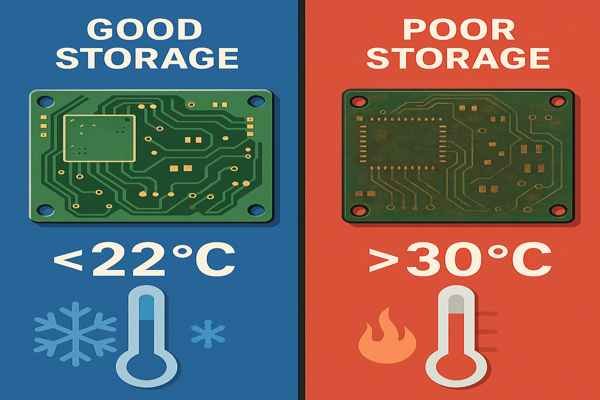
Temperature control is crucial for preserving PCB integrity during storage. High temperatures accelerate various degradation mechanisms. I recall a project where boards stored near a poorly insulated wall in summer showed significant tarnishing.
Impact of Temperature on PCBs
Different temperature conditions can have varying effects on stored PCBs:
| Temperature Condition | Potential Negative Effects on PCBs |
|---|---|
| High (e.g., \(>30^{\circ}\text{C}\) or \(86^{\circ}\text{F}\)) | Accelerated Oxidation, Faster Intermetallic Compound (IMC) Growth, Material Degradation (Laminate, Solder Mask), Reduced Shelf Life |
| Ideal (e.g., \(20-25^{\circ}\text{C}\) or \(68-77^{\circ}\text{F}\)) | Optimal for preserving material integrity and surface finishes |
| Fluctuating Temperatures | Condensation risk (if crossing dew point when moving from cold to warm/humid), potential mechanical stress over time due to expansion/contraction |
| Very Low (e.g., \(<10^{\circ}\text{C}\) or \(50^{\circ}\text{F}\)) | Generally less damaging than high temperatures, but primary risk is condensation when boards are warmed up in a humid environment |
General Temperature Guidelines
IPC-16022 recommends a controlled room temperature. A common guideline is to keep storage temperatures below \(25^{\circ}\text{C}\) (\(77^{\circ}\text{F}\)). Some PCB manufacturers specify a range, for example, \(20^{\circ}\text{C} \pm 5^{\circ}\text{C}\) (\(68^{\circ}\text{F} \pm 9^{\circ}\text{F}\)). Always check if the PCB manufacturer or specific surface finish has a more stringent recommendation. Stable conditions are preferred over wide swings.
What Are Moisture Barrier Bags (MBB) For PCBs?
Are your PCBs exposed to air during storage or shipping? This leaves them vulnerable to moisture damage and contamination.
Moisture Barrier Bags (MBBs) are specialized bags made from materials with a very low Moisture Vapor Transmission Rate (\(\text{MVTR}\)). They are designed to protect PCBs and electronic components from moisture damage.
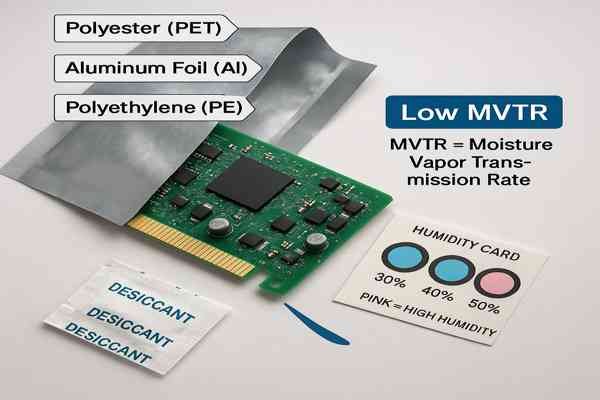
Moisture Barrier Bags are indispensable for protecting PCBs, especially those with finishes sensitive to humidity or intended for long-term storage. These are not ordinary plastic bags.
Understanding MBB Construction and Purpose
MBBs are typically multi-layered, often featuring an outer layer for durability, a metallic layer (commonly aluminum) for moisture and ESD shielding, and an inner layer of static-dissipative, heat-sealable polymer.
Key MBB Properties and Relevant Standards
The effectiveness of an MBB is defined by several properties, often specified by military or industry standards:
| Property | Typical Value/Standard Compliance Example | Importance in PCB Protection |
|---|---|---|
| Moisture Vapor Transmission Rate3 (\(\text{MVTR}\)) | \(\le 0.02 \text{ g}/100 \text{ in}^2/\text{24hrs}\) (per MIL-PRF-81705F Type I) or lower (e.g., \(\le 0.002 \text{ g}/100 \text{ in}^2/\text{24hrs}\) for high performance) | Primary indicator of how well the bag prevents moisture ingress |
| ESD Shielding | \(<50 \text{ nJ}\) Energy Penetration (ANSI/ESD S541 for shielding bags) | Protects against electrostatic discharge events |
| Static Dissipative (Inner/Outer Surfaces) | \(1 \times 10^4 \text{ to } <1 \times 10^{11} \Omega\) (ANSI/ESD S541) | Prevents triboelectric charge buildup on the bag surfaces |
| Puncture Resistance | e.g., \(>10 \text{ lbs}\) (per FTMS 101 MTH 2065) | Ensures bag integrity during handling and shipping |
When Are MBBs Essential?
I always use MBBs for boards with OSP, Immersion Silver (ImAg), or Immersion Tin (ImSn) finishes if storage is expected beyond a few days, or for any boards being shipped internationally or stored for months. They are also mandated by J-STD-033D for packaging moisture-sensitive devices.
When Should I Use A Desiccant With PCBs?
Using MBBs but still finding moisture issues? An MBB alone might not be enough if trapped air contains humidity.
A desiccant should always be used inside a sealed Moisture Barrier Bag (MBB) when storing PCBs. This is critical for absorbing any moisture trapped inside the bag during sealing or that slowly permeates the bag material over time.
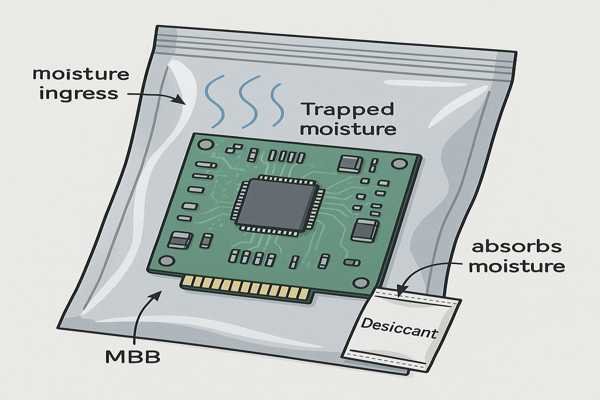
Desiccants are drying agents vital for ensuring the microenvironment inside an MBB remains dry. Even if an MBB is sealed in a low-humidity room, the air inside still contains some moisture.
The Role of Desiccants4
Desiccants work by adsorbing moisture molecules onto their surface. They create and maintain a very low relative humidity environment within the sealed MBB.
Comparison of Common Desiccant Types
Different desiccants have varying properties suitable for different applications:
| Desiccant Type | Adsorption Capacity at Low RH (e.g., \(20\%\)) | Adsorption Capacity at High RH (e.g., \(80\%\)) | Regeneration Feasibility | Typical Characteristics/Uses |
|---|---|---|---|---|
| Silica Gel | Moderate | Good | Yes (\(120^{\circ}\text{C}\) oven) | General purpose, can be indicating (color change) |
| Montmorillonite Clay | Good | Moderate | Yes (\(120^{\circ}\text{C}\) oven, slower) | J-STD-033 preferred, effective at low temps, low cost |
| Molecular Sieve5 | Excellent | Excellent | Yes (\(200-350^{\circ}\text{C}\) oven) | Very low RH needs, high temps, fast adsorption |
Determining the Right Amount
The amount of desiccant isn't guesswork. IPC/JEDEC J-STD-033D provides formulas to calculate "units" of desiccant based on bag surface area, \(\text{MVTR}\), storage time, and ambient conditions. One "unit" (MIL-D-3464E) adsorbs at least \(3\text{g}\) of water at \(20\%\) RH and \(6\text{g}\) at \(40\%\) RH, at \(25^{\circ}\text{C}\).
What Is A Humidity Indicator Card (HIC)?
Sealed your PCBs in an MBB with desiccant but unsure if it's working? You need a way to verify the internal conditions.
A Humidity Indicator Card (HIC) is a paper card with moisture-sensitive spots that change color to indicate the relative humidity level inside a sealed Moisture Barrier Bag or other controlled environment.
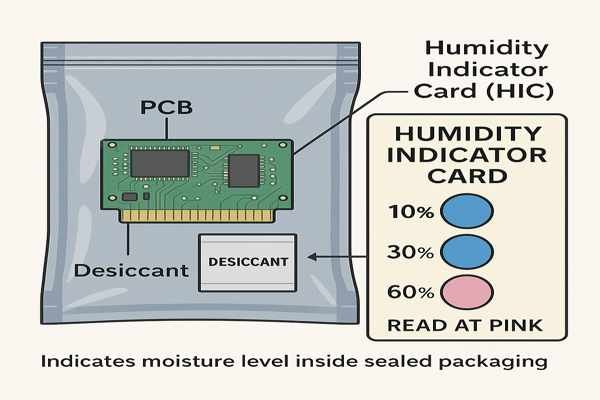
A Humidity Indicator Card is your simple, visual check on the effectiveness of your moisture barrier packaging. It tells you if the environment inside the MBB is truly dry.
How HICs6 Work
HICs contain chemical salts impregnated into absorbent paper spots. These salts change color as they absorb moisture and reach specific relative humidity thresholds. Common types are reversible.
Interpreting HIC Readings & Actions
HICs typically have multiple spots. The reading is the highest percentage spot that has changed color. Here are some examples for a common \(5-10-60\%\) HIC:
| HIC Spot Indication (Blue to Pink type) | Approx. RH Condition Inside Bag | Example Interpretation/Action (for MSL components) |
|---|---|---|
| All spots BLUE | \(<5\% - <10\%\) RH | Ideal. Package integrity maintained. Floor life clock stopped. |
| \(5\%\) spot PINK, \(10\%\) spot BLUE | Between \(5\%\) and \(10\%\) RH | Acceptable for many MSL levels. Monitor. |
| \(10\%\) spot PINK, \(60\%\) spot BLUE | Between \(10\%\) and \(60\%\) RH | Exceeds safe limit for some MSL. Floor life may be compromised. Bake if necessary per J-STD-033. |
| All spots (\(5\%\), \(10\%\), \(60\%\)) PINK | \(>60\%\) RH | Package failed. Desiccant saturated or seal broken. Bake required. |
Importance
According to IPC/JEDEC J-STD-033D, the HIC allows for immediate inspection. If a critical spot indicates high humidity, corrective action like baking the PCBs may be necessary.
Are Dry Cabinets Necessary For PCB Storage?
Dealing with high-value PCBs or frequent access needs? MBBs can be cumbersome if you're constantly opening and resealing.
Dry cabinets, which maintain very low relative humidity (e.g., \(<5\%\) RH or \(<10\%\) RH), are highly recommended for storing sensitive PCBs, especially for long durations, high-value boards, or when frequent access is needed.
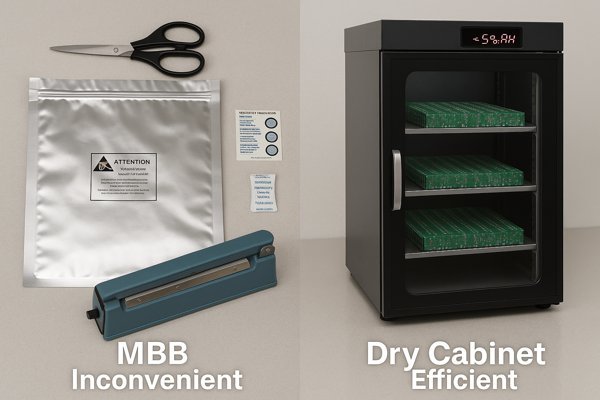
Dry cabinets offer an advanced solution for PCB storage, moving beyond passive methods to active environmental control.
Functionality of Dry Cabinets
These cabinets use desiccant dehumidification or nitrogen purging to achieve and maintain very low RH levels, often programmable from \(1\%\) to \(50\%\) RH. Many models can maintain \(\le 5\%\) RH.
When to Invest in a Dry Cabinet
Consider investing if you handle high-value PCBs, need frequent access for WIP, require long-term storage, or store MSL components where resetting floor life exposure is beneficial (J-STD-033D allows this at \(\le 5\%\) RH).
Cost-Benefit Analysis: Dry Cabinet vs. MBB/Desiccant
While initial costs are higher for dry cabinets (\(\$500 - \$10,000+\)), the long-term benefits can outweigh them.
| Feature | MBB + Desiccant | Dry Cabinet |
|---|---|---|
| Initial Cost | Low | Medium to High |
| Running Cost | Low (consumables: bags, desiccants, HICs) | Low (electricity for desiccant models) to Medium (\(\text{N}_2\) for \(\text{N}_2\) models) |
| Humidity Control | Passive, typically achieves \(<10\%\) to \(<40\%\) RH | Active, precise control, often \(\le 5\%\) RH, some to \(\le 1\%\) RH |
| Access Frequency | Low (laborious resealing needed) | High (easy door access) |
| Labor | Higher (bagging, unbagging, sealing) | Lower (place in/take out) |
| MSL Floor Life | Halts clock (if RH low enough) | Can reset clock (if RH very low, e.g., \(<5\%\) or \(<10\%\) per J-STD-033) |
| Monitoring | Manual (HIC check) | Often includes digital display, data logging |
How To Store ESD Sensitive PCBs?
Worried about invisible killers zapping your sensitive components? Electrostatic discharge can silently destroy or degrade PCBs during storage.
ESD sensitive PCBs must be stored in materials that provide shielding from electrostatic fields and allow safe dissipation of charges. This includes using ESD shielding bags and conductive or dissipative containers within an ESD protected area (EPA).
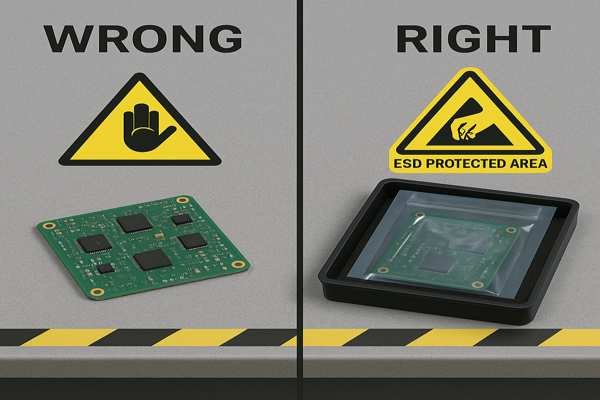
Electrostatic Discharge is a silent threat. Latent defects caused by ESD might pass initial tests but fail prematurely in the field.
Understanding ESD Risks to PCBs
ESD events from human touch (HBM), charged equipment (CDM), or materials can damage sensitive components with voltages far below human perception (around \(3000\text{V}\) for a felt shock, while \(<100\text{V}\) can damage sensitive parts).
Key Elements of ESD-Safe Storage
An ESD control program (e.g., per ANSI/ESD S20.207) includes an EPA, personnel grounding, and appropriate ESD protective packaging.
ESD Protective Material Categories and Properties
Different materials offer different types of ESD protection:
| Material Category | ANSI/ESD S541 Surface Resistance Range | Primary ESD Function | Common Examples |
|---|---|---|---|
| Shielding | (Specific test for shielding effectiveness, e.g., \(<50\text{nJ}\) discharge attenuation for bags) | Blocks electric fields (Faraday cage) | Metallized bags (e.g., metal-in, metal-out structure) |
| Conductive | \(<1 \times 10^4 \Omega\) | Rapid charge distribution/dissipation | Carbon-loaded plastics, conductive totes/bins |
| Dissipative | \(\ge 1 \times 10^4 \Omega \text{ to } <1 \times 10^{11} \Omega\) | Slow, controlled charge dissipation | Pink poly bags/foam, dissipative mats, garments |
| Insulative | \(\ge 1 \times 10^{11} \Omega\) | Prevents charge movement (can hold static charge, generally avoided in EPAs unless treated) | Standard plastics (PE, PVC), untreated wood |
What Are The Best Packaging Materials For PCB Storage?
Looking for the complete packaging solution for your PCBs? It's about combining moisture, ESD, and physical protection effectively.
The best packaging materials for PCB storage include Moisture Barrier Bags with desiccants and HICs for moisture control, ESD shielding bags for electrostatic protection, and physical cushioning like anti-static bubble wrap or foam in rigid, non-contaminating containers.
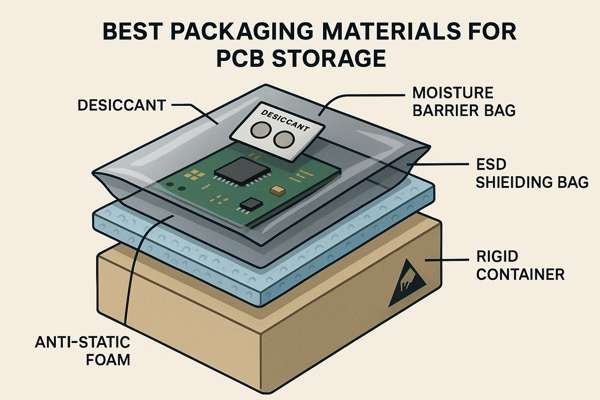
A holistic approach to PCB packaging for storage considers environmental, electrical, and physical threats.
Layered Protection Strategy
Effective packaging often involves multiple layers:
| Packaging Layer | Material Examples | Primary Protective Function(s) |
|---|---|---|
| Inner Contact/ESD | ESD Shielding Bag (may also be moisture-resistant), Conductive/Dissipative Trays, Sulfur-free Interleaving Paper | ESD Protection, Chemical Compatibility, Prevents Abrasion |
| Moisture Barrier | Moisture Barrier Bag (MBB)8 with Desiccant & HIC inside the ESD bag or as the outer sealed layer | Moisture Ingress Prevention |
| Cushioning | Anti-static Bubble Wrap9 (dissipative), Pink Polyethylene Foam (dissipative), Conductive Foam | Shock Absorption, Vibration Damping, Physical Damage Prevention |
| Structural/Outer | Conductive/Dissipative Totes, Corrugated Conductive Boxes, Rigid Boxes with Dissipative Liners | Stacking Strength, Handling Ease, Contamination Barrier |
Material Considerations for Compatibility
Avoid materials that outgas corrosive vapors or have high sulfur content if storing boards with sensitive finishes like silver (use sulfur-free paper10 as per IPC-1602). Ensure materials are low-linting.
Handling and Identification
Properly label all packages with part numbers, quantity, date of packaging, and any specific handling or environmental warnings (e.g., MSL level). Use "First-In, First-Out" (FIFO) inventory management unless a "fitness-for-use" assessment dictates otherwise.
Can PCBs Be Vacuum-Sealed For Storage?
Considering vacuum sealing to enhance PCB protection? It can be beneficial, but it's not a standalone solution and must be done correctly.
Yes, PCBs can be vacuum-sealed for storage, typically within a Moisture Barrier Bag (MBB). This process removes ambient air, improving desiccant efficiency and reducing bag volume, but it doesn't replace the need for an MBB and desiccant.
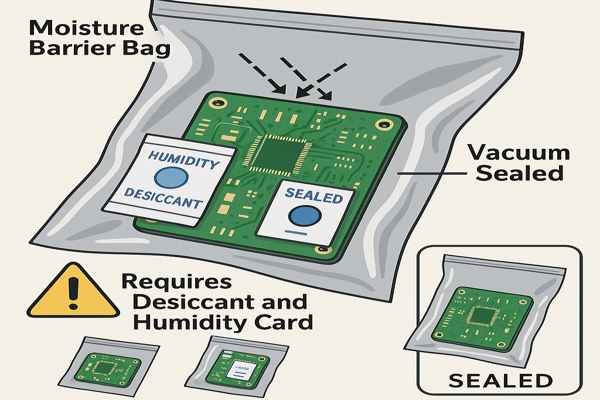
Vacuum sealing is often part of the packaging process for PCBs, particularly when using MBBs for long-term storage or shipping.
The Vacuum Sealing Process for PCBs
After placing the PCB (with desiccant and HIC, often already in an ESD bag) into an MBB, a vacuum sealer removes air before heat-sealing the bag.
Advantages and Considerations of Vacuum Sealing
Here's a quick summary:
| Aspect | Pro | Con / Consideration |
|---|---|---|
| Moisture Load | Reduces initial moisture in bag | Does not stop long-term \(\text{MVTR}\) through the bag material |
| Desiccant Life | Potentially extends desiccant effectiveness | |
| Package Volume | Reduces volume for shipping/storage | |
| Physical Stress | Can help immobilize contents if done right | Risk of damage if vacuum is too high/uneven; bag puncture |
| Process Integrity | Ensures better contact with desiccant | Requires proper equipment and procedure |
| Overall Protection | Enhances the MBB/desiccant system | Not a substitute for a quality MBB or adequate desiccant |
I've found vacuum sealing to be a standard and beneficial step in our high-reliability packaging procedures.
Conclusion
Proper PCB storage is vital. Control humidity and temperature, use MBBs, desiccants, HICs, and ESD protection. This preserves solderability and ensures long-term reliability for your products.
-
This standard provides essential guidelines for handling moisture-sensitive devices, ensuring their longevity and reliability. Check it out for best practices. ↩
-
Exploring IPC-1602 guidelines will provide you with essential standards for optimal PCB storage conditions. ↩
-
Understanding MVTR is crucial for ensuring effective moisture protection in sensitive electronic components. Explore this link for detailed insights. ↩
-
Explore this link to understand the various types of desiccants and their specific applications, enhancing your knowledge on moisture control. ↩
-
Learn about molecular sieves, their exceptional adsorption capabilities, and why they are crucial for low humidity environments. ↩
-
Understanding HICs is crucial for effective moisture control in packaging, ensuring product integrity and reliability. ↩
-
Learning about ANSI/ESD S20.20 provides insights into industry standards for ESD safety, essential for compliance and protection. ↩
-
Explore this link to understand how Moisture Barrier Bags protect sensitive items from moisture damage, ensuring longevity and reliability. ↩
-
Learn about the benefits of Anti-static Bubble Wrap in preventing static damage during shipping and storage, crucial for electronic components. ↩
-
Discover the significance of sulfur-free paper in protecting sensitive electronics from corrosion and ensuring product integrity. ↩



